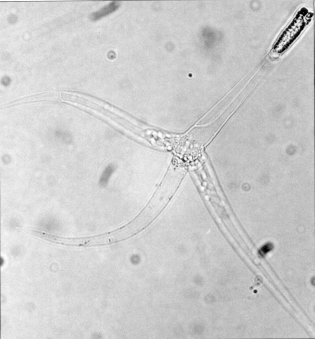
From ScienceDaily:
Researchers have found that a close cousin of the jellyfish has evolved over time into a microscopic parasite. The finding represents the first case of extreme evolutionary degeneration of an animal body.
…
Despite the radical changes in its body structure and genome over millions of years, the myxozoa have retained some of the basic characteristics of the jellyfish, including the essential genes to produce the jellyfish stinger.
“The myxozoa are microscopic — only a few cells measuring 10 to 20 microns across — and therefore biologists assumed that they were single-celled organisms,” said Prof. Huchon. “But when we sequenced their DNA, we discovered the genome of an extremely strange macroscopic marine animal.” More.
It mayn’t turn out to be all that rare. See: Devolution: Getting back to the simple life:
Sometimes, devolution offers an apparent advantage. Many plankton microbes eliminated the genes for producing key vitamins, and now outsource the function. One account suggests, “… most of the time, the fitness advantages of smaller genomes and lower cell replicating costs offset the potential fitness gains that would come from vitamin manufacture when the required nutrients are in short supply.”
Here’s the abstract:
The Myxozoa comprise over 2,000 species of microscopic obligate parasites that use both invertebrate and vertebrate hosts as part of their life cycle. Although the evolutionary origin of myxozoans has been elusive, a close relationship with cnidarians, a group that includes corals, sea anemones, jellyfish, and hydroids, is supported by some phylogenetic studies and the observation that the distinctive myxozoan structure, the polar capsule, is remarkably similar to the stinging structures (nematocysts) in cnidarians. To gain insight into the extreme evolutionary transition from a free-living cnidarian to a microscopic endoparasite, we analyzed genomic and transcriptomic assemblies from two distantly related myxozoan species, Kudoa iwatai and Myxobolus cerebralis, and compared these to the transcriptome and genome of the less reduced cnidarian parasite, Polypodium hydriforme. A phylogenomic analysis, using for the first time to our knowledge, a taxonomic sampling that represents the breadth of myxozoan diversity, including four newly generated myxozoan assemblies, confirms that myxozoans are cnidarians and are a sister taxon to P. hydriforme. Estimations of genome size reveal that myxozoans have one of the smallest reported animal genomes. Gene enrichment analyses show depletion of expressed genes in categories related to development, cell differentiation, and cell–cell communication. In addition, a search for candidate genes indicates that myxozoans lack key elements of signaling pathways and transcriptional factors important for multicellular development. Our results suggest that the degeneration of the myxozoan body plan from a free-living cnidarian to a microscopic parasitic cnidarian was accompanied by extreme reduction in genome size and gene content. Open access – E. S. Chang, M. Neuhof, N. D. Rubinstein, A. Diamant, H. Philippe, D. Huchon, P. Cartwright. Genomic insights into the evolutionary origin of Myxozoa within Cnidaria. Proceedings of the National Academy of Sciences, 2015; DOI: 10.1073/pnas.1511468112
Follow UD News at Twitter!